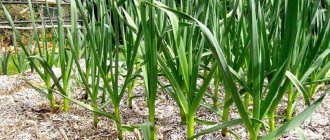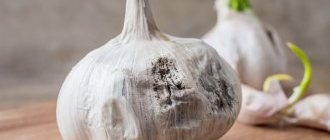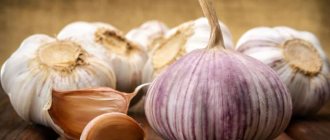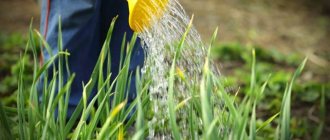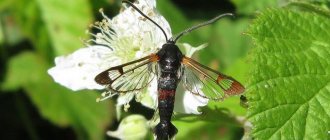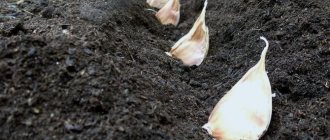Strewn with small elongated insects, the gradually drying twisted tops of shoots and leaf blades are often found in gardens and orchards. These are signs of the appearance of aphids, which are the most common pest that causes serious damage to the harvest of various crops.
Garlic infusions with their strong aroma can repel aphids, ants and other insects
It is important to organize the fight against dangerous insects at the first characteristic signs, since this will allow you to do without chemicals. Often, to make a folk remedy against aphids , which helps get rid of the insect that sucks the juices of plants, garlic is used in different forms.
Biochemical composition of garlic
The better the garlic is ripe, the more valuable elements it contains. Biochemical analyzes reveal the presence of seventeen mineral elements in garlic cloves: potassium, phosphorus, sulfur, iodine (see → use as a supplement), copper, manganese, etc.
In addition, garlic contains the following components important for the grower:
- Phytoncides. This term refers to substances that can destroy microorganisms. Garlic phytoncides have exceptional activity. Laboratory experiments prove that they kill Koch’s bacillus 6 times faster than the popular antiseptic “carbolic acid” (in 5 minutes versus 30).
- Diallyl disulfide. This substance is an organosulfur compound that gives garlic its specific smell.
In general, there are more than a hundred different sulfur-containing substances in garlic cloves. All summer residents who have at least once used colloidal sulfur on their plots are aware of the benefits of sulfur in the fight against plant diseases and pests. Thus, garlic can be considered a natural substitute for this chemical.
Garlic is not a simple substitute for colloidal sulfur, but an improved one. It contains essential oils and phytoncides, which are not found in the chemical preparation.
The effect of garlic on pathogenic microorganisms
The antimicrobial and antifungal effect is due to the large amount of phytoncides that garlic releases when cutting the cloves. The arrows of this plant can also be used to prepare medicinal preparations, however, such remedies will be inferior in effectiveness to those prepared from the cloves.
The mechanism of action of garlic phytoncides on pathogenic microorganisms includes several processes. First, they destroy the cell wall. Then they penetrate the cytoplasm and inhibit the enzymatic activity of the pathogen and its respiratory activity.
Not all phytopathogens are equally sensitive to garlic phytoncides. The causative agents of the following infectious diseases react most actively to garlic preparations:
- late blight;
- powdery mildew;
- fruit rot.
Garlic destroys not only microbial spores, but also mycelial cells, suppressing the proliferation of fungi.
Important! Garlic infusions are not effective against downy mildew. Garlic itself often suffers from peronosporosis, so it is not able to protect other plants from it. For the same reason, reports of the effectiveness of garlic remedies against fusarium are questionable.
Garlic phytoncides are destructive not only for pathogenic flora. In 3 minutes they kill the hay bacillus, which is beneficial for soil and plants. Therefore, after using garlic preparations, it is necessary to repopulate the area with this microorganism by treating it with Fitosporin-M.
Features of application
Garlic helps fight many insect pests that like to settle on vegetables, flowers, and berries. The following plants are treated with it:
- tomatoes;
- apple trees;
- cabbage;
- cucumbers;
- pepper;
- strawberries;
- currants;
- roses.
You can also include herbs (dill, parsley and lettuce), as well as indoor potted house plants. Aphids cannot tolerate the smell of garlic, so garlic is used against them in different ways:
- they make fragrant tinctures from it;
- use the whole cloves;
- arrows only;
- plants are planted between rows and among garden crops.
Garlic planted next to the beds performs a preventive function, so you don’t have to worry about the seedlings; aphids will no longer settle on them. But the most commonly used are garlic cloves. They are infused in an aqueous solution or simply stuck into the ground of plants affected by aphids, rubbed on trees and bush branches, and scattered in rows and beds.
The effectiveness of using garlic against aphids depends on several factors, the first of which is the presence of ants on the site. These insects live nearby because for the ant the aphid is a pet; they breed it and jealously monitor its movements. If aphids appear in your garden, you should find an anthill, get rid of its inhabitants, and only then destroy the pest that eats tomatoes and other plants.
The second factor is weather conditions. Plantings treated with garlic solution lose protection after rain, so it needs to be renewed. If growing garlic sits in the beds, it works much more effectively: insects do not settle near odorous plants.
Green arrows from garlic are laid out on the beds and between them, rubbed on tree trunks, and put on bush branches. The effect of such a product lasts several weeks; as the arrows dry, they are replaced with fresh ones.
Recipes for garlic infusions to combat plant diseases
To prevent infectious plant diseases, it is most convenient to prepare a universal concentrate. To do this, two large heads of garlic are twisted in a meat grinder along with the husks and placed in a glass jar. Then the garlic pulp is filled with water so that the volume of water is the same as the amount of garlic. The jar is closed with a lid and put away for 10 days in a dark, warm place.
After 10 days, the drug is filtered. The resulting concentrate is poured into a dark glass bottle and stored in the refrigerator. To treat plants, 25 ml of concentrate is added to 1 liter of water and used for spraying.
There are also more specialized garlic-based remedies:
| Disease | Recipe | Application |
| Late blight | Grind a large head of garlic in a meat grinder, mix the pulp with a teaspoon of dry mustard. Pour 2 liters of water, cover and leave for a day. Filter before use. | Dilute the resulting infusion in 8 liters of water. Use for spraying tomatoes, eggplants and potatoes when there is a threat of infection. |
| Powdery mildew | Peel 3 cloves of garlic, grate and put in 1 liter of whey overnight. In the morning, strain the product. Find out → how to use whey as a top dressing, how to dilute it. | Dilute the resulting whey-garlic infusion with 3 liters of water and treat the leaves of the plants. |
| Fruit rot | Pour a full head of garlic, twisted in a meat grinder, into 1 liter of warm water overnight. In the morning, strain the product and pour a bottle of brilliant green into it. | Dilute the resulting solution with water 1:10 and spray the plants over the fruits and ovaries. |
These funds are not stored. They must be used immediately after preparation.
Tip #1. Phytoncides are volatile substances and quickly go into the air when garlic is twisted in a meat grinder. Therefore, you need to perform all the steps quickly and seal the jars in which the infusions are prepared well.
Garlic sprays, unlike pesticide sprays, can be safely carried out on the fruits. No negative effect or accumulation of harmful substances is observed.
Methods of application
To protect your garden from aphid invasion, you can use various folk recipes that include garlic. Spraying can be carried out in early spring and late autumn, thereby preventing the reappearance of parasites.
In its purest form
This method involves planting a vegetable with strong bactericidal properties and a variety of phytoncides in beds where cultivated plants are located nearby. Essential oils repel pests with their unpleasant aroma. It is better to plant garlic in the fall, so that with the onset of spring it will grow faster. It is effective to plant this crop around the perimeter of the entire site.
Garlic arrows
Garlic arrows are inflorescences. They must be cut off, as they reduce the quality of the crop. The torn arrows can be hung on a tree, shrub or cultivated plants. The aroma they emit prevents aphids from settling on these plants.
cloves
Peeled garlic cloves can be spread on beds where mites are growing. Their phytoncides will drive away pests, preserving the harvest. You should periodically add fresh portions of the vegetable so that the aroma does not lose its strength.
Solution
Crops can be treated by spraying their vegetative mass with garlic solution. A “medicine” of different concentrations is suitable, calculated according to the degree of damage to the shoots.
From cloves
You can prepare a solution from garlic cloves by crushing them in the amount of one glass and then pouring 10 liters. cooled boiling water. This product can be used a day after preparation.
When using a solution of garlic cloves, make sure that there is no unpleasant odor. Otherwise, you won’t be able to deal with the brazen aphid colony!
Pounded
Garlic cloves can be ground into a paste and spread around the affected plants. The active esters of the vegetable will irritate the sense of smell of insects. As a result, the parasites will leave the plant treatment areas. The procedure should be carried out several times during the season.
Soap solution
To prepare such a concentrate, dissolve 0.5 liters in two liters of warm water. pre-peeled and chopped garlic cloves. The resulting mass is removed for a day in a warm, dark place to infuse. After the required time, a piece of laundry soap grated through a grater is added to the concentrate. After the soap slivers are completely dissolved, everything is filtered and the resulting liquid is sprayed on the affected plants.
More effective ways to use soap solution against aphids
Infusion
An effective remedy against aphid infestation on plants is an infusion of garlic. It can be prepared in different ways. Let's look at the options below.
Classic recipe
According to it, take a glass of peeled garlic cloves and fill them with cold water. Cover the mixture with a tight lid and leave for about three days. After this time, the product can be used to combat parasite colonies.
Concentrated
The concentrated infusion is prepared in a 1:1 ratio. To do this, garlic minced in a meat grinder is poured with the same volume of cooled boiling water, and then placed in a warm, dark room to infuse. This product should last for at least a week. The finished infusion is used for spraying at the rate of dissolving 50 ml of the prepared medicine in a 10-liter bucket.
Soap-oil concentrate
The product is prepared as follows: water at room temperature (0.5 l.), liquid soap (5 ml.), vegetable oil (10 ml.) and crushed garlic cloves (5 pcs.) are mixed together. Everyone insists for 5 days, followed by straining. The resulting solution is poured into a spray bottle and sprayed onto the affected plants.
Blend with tobacco and onion
50 g of chopped onion peels are poured with 2.5 liters of water. Tobacco dust (50g) is added to the resulting mass and boiled for about 2 hours. The resulting product is infused for 1 hour, to which then crushed garlic pulp (50g) is added. After dilution of 5 l. ready-made liquids are used to irrigate sick plants.
On garlic peel
At 10l. Garlic peels (200g) placed there are infused in warm water for 2 days. Then everything is filtered and the resulting mixture is irrigated on the diseased plants.
Use the garlic peel aphid repellent as a treatment for at least a week. The protection created in this way can cope with adult ticks and their larvae.
Effect of garlic diallyl disulfide on insects
Garlic actually copes well with many pests if their colonies are not too large. But it does not kill insects, but repels them.
The repellent effect of garlic is due to the presence of the aforementioned diallyl disulfide. Insects, in search of food, navigate mainly using their sense of smell, which is fantastically acute. For example, a cabbage butterfly can smell a cabbage leaf a kilometer away from the garden bed.
Diallyl disulfide is a pungent-smelling compound. When contacted with leaves, solutions containing this substance mask the natural aroma of the plant and make it “invisible” to the pest. Thus, garlic infusions help cope with those insects that come to the garden “by smell”:
- cabbage butterfly;
- carrot fly;
- cabbage scoop;
- cabbage moth;
All pests are repelled by garlic +6 (click to expand)
- whitefly;
- aphid;
- codling moths;
- cruciferous flea beetle;
- weevils;
- Colorado beetle.
Diallyl disulfide is a stable compound, so the protective effect of garlic products lasts for several days in good weather.
Recipes for garlic infusions to combat insect pests
It is better to enrich garlic infusions with some kind of adhesive so that they stick better to the leaves and shoots. Typically, laundry soap is used for this purpose, but you can replace it with tar soap:
| Recipe | Preparation | Application |
| Garlic infusion with dandelion | 1 kg of dandelion leaves and roots is crushed and placed in a bucket of water. After two days, 5 chopped heads of garlic are added to them along with the husks. After another day, the solution is filtered, half a bar of laundry soap is added to it. | Places where insects accumulate are abundantly irrigated with infusion. You can also spray young shoots to prevent damage. |
| Garlic infusion with celandine | 1.5 kg of celandine greens is chopped with a knife and combined with chopped 6 heads of garlic. Everything is filled with a bucket of water and infused for 5 days. Then it is filtered and combined with a solution of tar or laundry soap. | A broom is moistened in a bucket with a solution and irrigation is carried out over the potato tops. This procedure effectively protects the plot from the attack of the Colorado potato beetle. |
| Wormwood-garlic infusion | 1 kg of wormwood greens is chopped with a knife and combined with 5 chopped heads of garlic. Everything is filled with a bucket of water and infused for 3 days. Then it is filtered and combined with a soap solution. | Plants that need protection from insects are sprayed with the infusion. |
To maintain the effect, these infusions need to treat the plantings regularly - approximately once every 5 days. If the weather is rainy, spraying is carried out after each rain.
To protect against codling moths, cabbage cutworms and other nocturnal pests, spraying is carried out in the evening so that the smell of the product is fresh and effectively repels insects.
Citrus peels
Dried citrus peels repel many insects! They can be placed in a moth closet, as well as in flower pots to combat midges and fools. The peels of any citrus fruit are suitable for this - lemon, orange, tangerine, lime, grapefruit. Spread them on the surface of the soil, or chop them and sprinkle them on the soil in a flower pot. It is better to do this the next day after watering, or 4-5 days before watering.
To combat more serious pests - aphids, scale insects and mealybugs, you can also spray the citrus peel with an infusion. For this, 100 gr. dry or fresh raw materials, pour a liter of warm water and leave in a dark place for 4 days.
citrus peels and garlic
Garlic against spider and kidney mites
The great advantage of garlic infusions is that they are effective not only against insects, but also against ticks. Not every chemical has such a dual effect.
- Garlic infusion with dandelion is used to protect against spider mites. Spraying is carried out generously, wetting the entire above-ground part of the plants. Since spider mites reproduce most actively in hot, dry weather, in hot weather, spraying can be done more often than usual - once every 3 days.
- A universal concentrate is suitable for protection against currant bud mite. In early spring, it is diluted in hot water at the rate of 250 ml per 10 liters of water and poured over the currant bushes until the buds awaken.
To combat bud mites in late spring, during the period of currant budding, you can additionally spray the bushes with an infusion of garlic and dandelion.
Garlic infusions for flowers
There are plants that, when adjacent to other flowers, are able to create a barrier against pests and diseases. These are the so-called phytoncide plants! These include gypsophila, lavender, matiola bicornuum, nasturtium, as well as spicy aromatic herbs - basil, coriander, mint, sage, thyme, lemon balm, even the usual dill and parsley, as well as the previously mentioned wormwood.
Why not grow a small garden, or a fragrant mini-vegetable garden on the balcony? The smell of such plants will repel pests. Thus, once on the balcony, indoor flowers will be protected by natural flavors! And by planting aromatic plants and herbs in the garden plot, you will not only decorate the flowerbed, but also protect the flowers from the invasion of “uninvited guests”. Double benefit!
spices and matthiol
Some plants act not only above the ground, but also in the soil, protecting neighbors from parasites and bacteria. Such universal flowers include calendula and marigolds. By sowing the empty spaces in the flowerbed with them, you will protect the flowers from fungal and viral diseases. By the way, an infusion is also made from marigold flowers, which is successfully used in the fight against pests and diseases!
To do this, collect faded marigolds along with the leaves, put them in a saucepan and fill them with hot water 1:1, let them brew for 2 days. The strained infusion can be used for spraying against aphids, mites, whiteflies, thrips, and for the treatment of fungal diseases. It will also be useful for seedlings – against “black leg”.
Garlic infusion against pests is also used for watering flowers decorating the garden plot. Gladioli are protected from fusarium by planting 1 row of garlic between 2 rows of flowers, as well as by watering and spraying with garlic infusion.
We suggest you read: How to infuse moonshine on walnut partitions
If it is not possible to protect the flowers by simply planting garlic, you can spray the plants with an infusion of garlic prepared from 300 g of crushed plant and 5 liters of water. The infusion, strained after 2 days of aging, is used for watering flowers at the rate of 10 liters of water per 1 half-liter jar. It is strictly forbidden to water and spray in sunny, hot weather.
There is another way to infuse garlic for watering flowers:
- Pour crushed 600 g of garlic into a bucket of hot water.
- Boil covered over low heat for 3 hours.
- Strain the broth and dilute it by half again with water.
- The finished decoction should sit for at least a day.
- Water the soil at the rate of 0.5 liters per 1 square meter.
An infusion of onion and garlic is used against pests that destroy the plant not only from above, but also in the soil:
- Boil 50 g of onion peels and 50 g of tobacco dust in 2.5 liters of water for 2 hours.
- The broth is infused for an hour and 50 g of ready-made garlic pulp is added.
- Dilute the prepared composition in 5 liters of water.
- Plants already infected with other diseases are also used against aphids. Flowers can be irrigated.
Garlic as a deterrent in mixed plantings
Another way to use garlic to protect plants from pests is mixed plantings. This term denotes a method of organizing a vegetable garden in which plants are planted not according to the principle of “one crop - one bed,” but mixed up.
What plants can you plant garlic with (click to expand)
Garlic is a universal crop. It can be planted next to almost any garden plant - beets, radishes, potatoes, strawberries, cucumbers, tomatoes, peppers, eggplants. Even in flower beds, garlic looks quite decorative, while at the same time protecting flowers from pests.
Also very popular is the joint planting of garlic and carrots:
“Planting garlic and carrots together is an effective means of protection against carrot flies. This insect is attracted to chlorogenic acid, which is secreted by carrot leaves. Moreover, the juicier and sweeter the variety, the more chlorogenic acid is released by the carrot tops. Garlic interrupts this aroma, both above the ground and in the area of the root crop, where the carrot fly lays its eggs.”
ON THE. Serebryannikova, natural farming expert
The only undesirable neighbors for garlic are legumes. Also, according to some reports, this culture negatively affects the taste of cabbage.
Garlic protects garden strawberries well from weevils, mites, leaf beetles and nematodes.
Fourth method
Liquids made from garlic also have a positive effect on flower plants. For example, aphids and spider mites will not settle on roses if you pre-treat them with this infusion.
Also, to strengthen the solution, it can be used when watering bulbous flowers - daffodils, tulips and hyacinths.
Disinfection of planting material using garlic
Using garlic infusions, you can sanitize planting material. Experienced gardeners who grow garden strawberries for sale often practice this method:
- 150 ml of universal concentrate is diluted in a bucket of water;
- garden strawberry bushes are completely immersed, together with leaves, in the solution;
- stand for 20 minutes, lightly dry the planting material under a canopy and plant it in the garden bed.
This method of disinfection with garlic infusion is especially recommended for planting material purchased “outside” - in nurseries, on the market or from neighbors.
Current questions about the use of garlic infusions
Question No. 1. Is it possible to defeat mealybugs on an orchid with garlic infusion?
Can. But this must be done carefully, wiping the orchid leaves with a cotton sponge. Prepare a solution from 10 ml of universal concentrate per 1 liter of water. After treatment, do not place the orchid in direct sun.
Question No. 2. Is it possible to water the soil with garlic infusion? (click to expand)
It is possible, but you should remember that this product is detrimental to soil flora. A week after such watering, it is necessary to restore the microbiological activity of the soil using any EM preparation (find out → types of EM preparations + reviews).
Rate the quality of the article. We want to be better for you:
